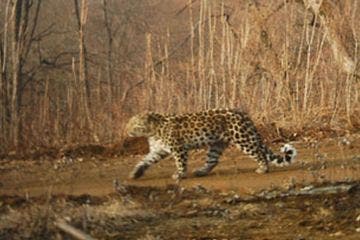
A rare Amur leopard was photographed for the first time at the Hunchun Amur Tiger National Nature Reserve in northern China. (Hunchun Amur Tiger National Nature Reserve /Courtesy)
The Amur leopard is a beautiful leopard subspecies native to the region of the Russian far east, which since 1996 has been classified as critically endangered. Only a handful of specimens remain today, however a photo which surprised an Amur leopard in China suggests that the species’ numbers are steadily increasing, and conservation efforts are beginning to show signs of promise.
The photo was captured by one of the camera traps spread across the Amur Tiger National Nature Reserve in Jilin Province in northern China. Most of the wild Amur leopard population lives across the border in Russia, where last winter camera traps snapped photos of 29 individual leopards. It’s now estimated that between 8 and 12 individual Amur leopards live in the Chinese province, as well.
via Global Post









